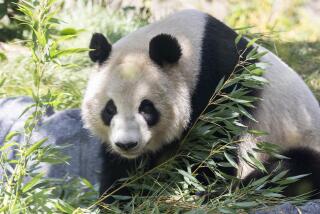Celebration turns to grief with death of one of the panda twins at National Zoo
- Share via
Reporting from Washington — One of two pandas whose weekend births captured world attention died Wednesday, a reminder that the bears who grow into giant puffy icons enter the world as fragile creatures, hairless and weighing about as much as a bar of soap.
The birth of the twins at the Smithsonian’s National Zoo on Saturday night created a frenzy of excitement, crashing the zoo’s “panda cam.” Only four American zoos have giant pandas, and they have become a symbol of preservation and a star attraction.
But by Wednesday, excitement turned to grief.
“When we realized the cub wasn’t going to make it, it was devastating,” Brandie Smith, associate director of animal care sciences for the National Zoo, said at a news conference.
The cub had been at risk from the beginning, owing to its small stature and the difficulty panda mothers have in manipulating two babies at once.
“These cubs are very fragile,” said Don Neiffer, the zoo’s chief veterinarian. “Pandas don’t have a great track record at trying to raise twins.”
Neiffer said it would take time to learn the exact cause of death through a full necropsy and, possibly, further study of the bear’s tissue.
Zookeepers said the larger of the two cubs appears to be in good health and is with its mother, Mei Xiang. Neither of the two cubs had been named, nor have their genders been determined.
“We still have a very healthy mom and one very healthy baby,” Smith said.
To compensate for Mei Xiang’s challenges in caring for both cubs at once, zoo officials had attempted to swap the cubs out every few hours. But the plan depended on Mei Xiang’s willingness to trade babies with veterinarians and other caregivers, something Mei Xiang resisted at times because she is, according to Neiffer, “a fiercely good mother.”
Mei Xiang, however, did not appear to favor one cub over the other, Smith and Neiffer said. She tried but failed to give them equal attention since their birth.
But the smaller cub had struggled, requiring tube feeding. A specialist in panda twins from Zoo Atlanta, the only American zoo to successfully breed giant panda twins, traveled to Washington as soon as the cubs were born, part of a team of experts giving the cubs round-the-clock attention.
On Tuesday afternoon, the smaller cub appeared to be getting healthier, leaving an incubator to spend time with its mother to get nutrients, gain weight and bond, Neiffer said.
But zookeepers could not see the cub clearly, as it was 1,500 times smaller than its mother and could easily be hidden under her chin or armpit, he said.
“So we relied a lot on what mom was doing,” he said. “She never showed us any signs that she was concerned about her infant.”
On Wednesday morning, when zookeepers swapped the cubs again, they noticed the smaller cub was not faring well — failing to gain weight, appearing weaker and showing signs of respiratory problems.
“Despite extreme efforts on the part of our dedicated staff, we weren’t able to change things,” Neiffer said.
The cub died just after 2 p.m.
Twitter: @noahbierman
ALSO:
Panda is getting help from National Zoo staff in caring for newborn twins
Baby pandas born and bred at National Zoo are not birthright citizens
Can’t wait to see D.C.’s panda babies? Four places to behold that cuteness right now
More to Read
Sign up for Essential California
The most important California stories and recommendations in your inbox every morning.
You may occasionally receive promotional content from the Los Angeles Times.











